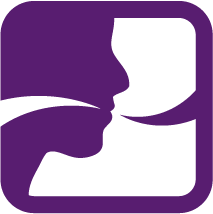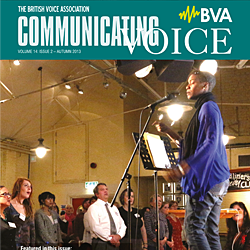About the Association
Archived newsletter articles
The Voice Skills Perceptual Profile
British Voice Association event report – by Christina Sherwell, MA CERT MRCSLT ADVS
"I See A Voice"
Nick Bottom as Pyramus in A Midsummer Night's Dream
The audience usually laughs at Bottom's words, but actually, as voice practitioners, we do see voices. We meet the speaker or singer with whom we are to work and we see the body shape, habitual postures, expression, the struggle or ease with which someone voices, the signs of strain in their neck - and so much more. We use our own ears, hands and eyes - as well as that other power of intuition - to find out all we can before we begin to work with that person.
But there is another meaning to the image of 'seeing a voice', and that is the use of some sort of perceptual analysis, which enables us to organize what we hear into a structure to aid understanding and guide action.
The use of a formalized perceptual scheme can also be used to evaluate progress over time, to organize the feedback to clients, to communicate with colleagues and to carry out research.
There are many different Voice Practitioners who work practically with individuals, to change the quality of a speaker or singer's voice. For the purposes of this article my focus is on three main groups - voice teachers, speech and language therapists and singing teachers. Their approach varies along the continuum of art and science, experience and analysis.
DeBoer and Shealy (1995) put it well: "Together voice science and voice art form a continuum that is highly technical and medical at one extreme, and aesthetic or abstract at the other, affording a wide range of approaches to vocal transformation'.
Speech and language therapists mainly use explanation and direct instructions. Voice teachers and singing teachers use both imaginative and direct methods, and vary as to how much anatomical explanation they use. But individual practitioners can use whatever methods they feel appropriate in their voice work, and the best will use a mix of art and science, imagination and rational logic.
All practitioners decide how to work with a person's voice by identifying what is actually happening, based on what they hear. Formal perceptual analysis of voice can help clarify the answer to a question like 'what on earth is going on in this voice?" but is usually only used in voice therapy. Voice and singing teachers rarely use any kind of formal perceptual voice scheme, though at RADA and LAMDA we are using such a scheme to analyse the young actors' voices at the beginning and end of training.
A perceptual voice scheme does not have to be a dry and sterile structure - it can accord with our intuitions, and breathe new insights into our holistic understanding of a person's spoken voice.
A perceptual scheme for all voice practitioners?
Over a period of ten years of work with voice disordered clients, acting students, speakers developing their vocal and presentation skills, voice workshops and university students, I have come to recognise that the basic parameters of healthy and effective voice are the same whether we work with voice aesthetics or voice disorder.
From this recognition has come the idea of eight core functional aspects of voice, which I call The Voice Skills approach. This is not a narrow rigid method, but a flexible model through which we can view voice, and orqanize our thinkinq. The eight aspects are: Body, Breath, Channel, Note, Resonance, Pitch, Volume and Articulation. They form the basis of the Voice Skills Perceptual Profile (VSPP).
As part of my interest in the common ground of voice work, I decided to explore a question. Would it be possible to develop a fairly simple perceptual voice assessment tool that would be useful to any voice practitioner? It might also offer a small contribution towards the impossible dream of a shared terminology for us all, which would certainly help communication!!
My aim was to develop a listening tool that would offer insights into the vocal quality and usage along the whole continuum of the spoken voice from severely disordered to well trained. It is would not be deficit based, but a "What have we here?" scheme I designed a scheme which enables us to note personal observations under certain 'sensible' headings, giving us useful qualitative information to guide the direction of appropriate voice work for a client, AND which also generates quantitative information if we want to compare the voice before and after training or therapy.
Many voice practitioners, in all groups, are deterred from doing their own voice research by what they see as a focus on statistical emphasis. They do not want to have to complete a long test that gives them numbers rather than descriptions, or to use what they see as a test assessing only a tiny part of the voice. It was ever thus in research by the practical professions - a clash between what is seen as the art of practice and the science of research.
The Voice Skills Perceptual Profile
The VSPP enables the assessor to utilize the eight core Voice Skills aspects for both quantitative rating scales, and for qualitative descriptive evaluation, to be recorded on one simple form. The Profile thus provides a tool for research and practical guidance in planning appropriate therapeutic action.
Early in 2005 I decided to carry out a simple research project to see whether a group of mixed voice practitioners would find the VSPP scheme to be a useful tool in their work, and whether these practitioners could be trained to ensure good interjudge reliability in the numerical ratings.
A professionally mixed group of 13 voice practitioners (eight speech and language therapists; three voice teachers; one singing teacher; one voice teacher/ speech and language therapist) completed a two-day training in the VSPP. Two client videos were shown at the start of the course, and two at the end. In each case, one of the pair was a client with a voice disorder, and the other was a client who wanted to improve their vocal style in presentation. The voice practitioners were asked to describe, and to rate, each client on all VSPP parameters, and their totals were compared with that of the author. They were also later asked to complete a questionnaire about the usefulness of the VSPP to their work. The results of the research do suggest that the VSPP is a useful tool for voice practitioners.
Interjudge reliability is recognised as being problematic in perceptual voice schemes (Kreiman et all 1993) but this study suggests that there is a likelihood of reasonable VSPP rating agreement.
The voice practitioners on the course agreed that the VSPP provides a high quality perceptual tool for voice development, and voice remediation. 12/13 rated the VSPP as very useful as an assessment tool with clients and 11/13 rated it as very useful as a tool to plan training/therapy with clients. All 13 approved the use of both quantitative and qualitative sections in the VSPP, intended to continue to use the VSPP in the future if it were published, and to recommend the VSPP to other practitioners.
The The Voice Skills Perceptual Profile can be taught to practitioners in a two day course Its ability to offer both descriptive and numerical options in voice description is seen as both unusual and desirable, and it can be considered to be a useful tool in the voice worker's treasure chest.
More archived content online
Disclaimer
Neither the British Voice Association nor the Editor can be held responsible for errors or any consequences arising from the use of information contained in its newsletters (or extracts from its newsletters published online); the views and opinions expressed do not necessarily reflect those of the British Voice Association (BVA) or the Editor, neither does the publication of advertisements constitute any endorsement by the BVA or Editor of any products or services featured.

 Join us Now!
Join us Now! our newsletter
our newsletter free voice care leaflets & information – download here
free voice care leaflets & information – download here Help our work by donating while you shop
Help our work by donating while you shop